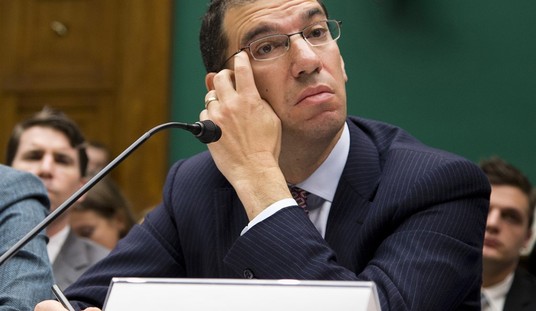It’s Jeremy Faust, who wrote two widely read semi-encouraging pieces about COVID-19 for Slate recently. (Maybe the only semi-encouraging pieces about the disease to appear online over the last two weeks, in fact.) I linked both when they were published but here they are again: “Why the Silent Spread of Coronavirus Might Actually Be a Good Sign” and “COVID-19 Isn’t As Deadly As We Think.” His point in each is straightforward, that there’s every reason to believe coronavirus won’t be deadly to most people based on the data we already have. It almost never kills children, rarely kills young adults, and may not be much more deadly than the common flu to middle-aged adults. In fact, in the one somewhat “controlled” experiment we have — the Diamond Princess cruise — death rates were lower than the data from China led us to expect.
Which is great. But there are three wrinkles. First, the numbers for older adults are very frightening. Here’s a new study that’s going around today:
Useful new analysis by @C_Althaus et al, which adds to evidence on COVID-19 case fatality rate. They estimate higher values than us, but even if there is still uncertainty about exact overall value, the age pattern of severity is striking https://t.co/n5BqcYwmCE https://t.co/pNQaGITaWg pic.twitter.com/PFp0YofW82
— Adam Kucharski (@AdamJKucharski) March 7, 2020
No worse than the flu for the under-40 crowd. Then it inches up for the 40-49 crowd. Then inches up further for 50-59. And then, at around age 60, we have lift-off. Septuagenarians have a one in 10 chance of death. The overall death rate ends up at 1.6 percent, considerably higher than the flu because the high mortality rate among older people drags up the average. Faust emphasizes that too in the clip below, as you’ll see: Senior citizens and people with underlying illnesses are the priority. They’re facing catastrophe.
But looking at death rates from COVID-19 is too simple. That’s the second wrinkle. The threat from an epidemic isn’t merely whether the disease will get you, it’s whether it will cripple basic services — medical services, first and foremost — and thereby make it much easier for something else to get you. If your stomach can take it, read this thread projecting what the load on the U.S. health-care system might be as soon as early May. It’s not just the death rate that matters; the hospitalization rate matters too. And of course the two are linked. If you come down with coronavirus, or flu, or any other disease, infectious or otherwise, and can’t get a bed because hospitals are overwhelmed with COVID-19 patients, your risk of dying from whatever you have will obviously increase considerably.
The death rate might be 1.6 percent when there’s enough capacity to treat everyone to the full extent that their illness requires. What’s the rate when there isn’t?
The third wrinkle, as you already know, is that the CDC has utterly blown its chance to put out this fire before it spread:
[O]nce the CDC finally began its national testing regime, it faltered in almost every way imaginable.
The initial tests didn’t work, and officials are probing whether there was possible contamination. The protocol for who could be tested was restricted to people already known to have been exposed to the virus or who had been in China, even as the epidemic raced to multiple countries like Japan, South Korea, Italy and Iran…
Airport passenger screening has gotten less scrutiny than testing, but it appears to be lagging, too. Acting Homeland Security Secretary Chad Wolf told House lawmakers that Customs and Border Protection and medical staff had screened more than 50,000 passengers on flights from China and Iran who were funneled through 11 airports. But the screening, which involved measures such as testing people for elevated body temperatures, may have detected only one in three infected travelers arriving from overseas, Harvard School of Public Health communicable disease expert Marc Lipsitch told a news briefing this week.
Trump’s limited ban on travel to China slowed down the spread temporarily, but new research shows that travel bans likely buy a few weeks at most. When Politico asked one public-health expert what went wrong with the feds’ response, his answer was, “What went right?”
Here’s Faust, who’s tweeting about the crushing delay in coronavirus testing today, on CNN this morning followed by a pandemic expert who worked for Bush and Obama with a far grimmer assessment of the situation. In a few weeks, when the extent of the contagion is better known, it seems a cinch that pro sports leagues will have to start turning away fans in order to limit community spread. (The NBA is already discussing it.) Since the virus can’t be contained anymore, the only option is collective self-isolation to the greatest extent feasible unless and until doctors find a drug cocktail that works.
“Hoarding is not going to help. The panic is not going to help. What’s going to help is focusing our attention on those elderly and sick people whose lungs cannot handle this,” Dr. Jeremy Faust says to @smerconish about coronavirus. https://t.co/gAD4haqfgh pic.twitter.com/wRoa2JxMOM
— CNN (@CNN) March 7, 2020
"This is the most frightening disease I've ever encountered in my career."
Richard Hatchett, the doctor leading efforts to find a vaccine for coronavirus, says it is much more lethal than normal flu. pic.twitter.com/1tjJ2ed0Hq
— Channel 4 News (@Channel4News) March 6, 2020








Join the conversation as a VIP Member